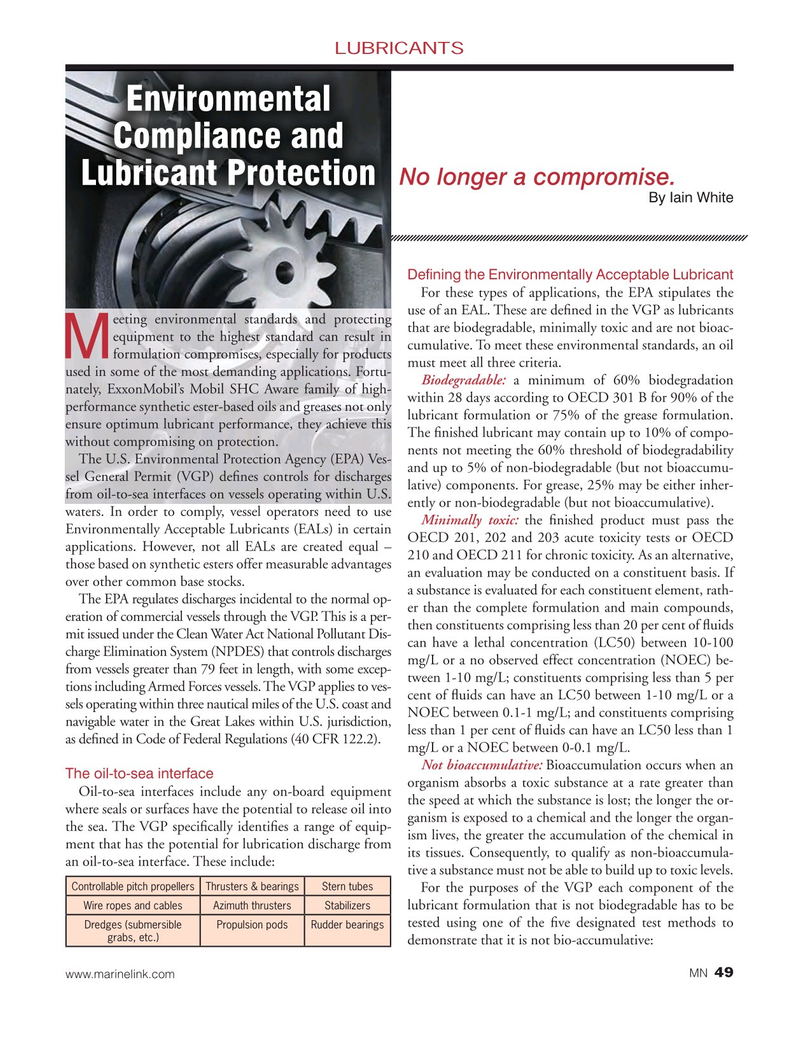
Page 49: of Marine News Magazine (June 2016)
Combat & Patrol Craft Annual
Read this page in Pdf, Flash or Html5 edition of June 2016 Marine News Magazine
LUBRICANTS
Environmental
Compliance and
No longer a compromise.
Lubricant Protection
By Iain White
De? ning the Environmentally Acceptable Lubricant
For these types of applications, the EPA stipulates the eeting environmental standards and protecting use of an EAL. These are de? ned in the VGP as lubricants equipment to the highest standard can result in that are biodegradable, minimally toxic and are not bioac- cumulative. To meet these environmental standards, an oil
M formulation compromises, especially for products must meet all three criteria. used in some of the most demanding applications. Fortu-
Biodegradable: a minimum of 60% biodegradation nately, ExxonMobil’s Mobil SHC Aware family of high- within 28 days according to OECD 301 B for 90% of the performance synthetic ester-based oils and greases not only lubricant formulation or 75% of the grease formulation. ensure optimum lubricant performance, they achieve this The ? nished lubricant may contain up to 10% of compo- without compromising on protection.
nents not meeting the 60% threshold of biodegradability
The U.S. Environmental Protection Agency (EPA) Ves- sel General Permit (VGP) de? nes controls for discharges and up to 5% of non-biodegradable (but not bioaccumu- lative) components. For grease, 25% may be either inher- from oil-to-sea interfaces on vessels operating within U.S. waters. In order to comply, vessel operators need to use ently or non-biodegradable (but not bioaccumulative).
Minimally toxic: the ? nished product must pass the
Environmentally Acceptable Lubricants (EALs) in certain OECD 201, 202 and 203 acute toxicity tests or OECD applications. However, not all EALs are created equal – 210 and OECD 211 for chronic toxicity. As an alternative, those based on synthetic esters offer measurable advantages an evaluation may be conducted on a constituent basis. If over other common base stocks.
a substance is evaluated for each constituent element, rath-
The EPA regulates discharges incidental to the normal op- er than the complete formulation and main compounds, eration of commercial vessels through the VGP. This is a per- then constituents comprising less than 20 per cent of ? uids mit issued under the Clean Water Act National Pollutant Dis- can have a lethal concentration (LC50) between 10-100 charge Elimination System (NPDES) that controls discharges mg/L or a no observed effect concentration (NOEC) be- from vessels greater than 79 feet in length, with some excep- tween 1-10 mg/L; constituents comprising less than 5 per tions including Armed Forces vessels. The VGP applies to ves- cent of ? uids can have an LC50 between 1-10 mg/L or a sels operating within three nautical miles of the U.S. coast and navigable water in the Great Lakes within U.S. jurisdiction, NOEC between 0.1-1 mg/L; and constituents comprising less than 1 per cent of ? uids can have an LC50 less than 1 as de? ned in Code of Federal Regulations (40 CFR 122.2). mg/L or a NOEC between 0-0.1 mg/L.
Not bioaccumulative: Bioaccumulation occurs when an
The oil-to-sea interface
Oil-to-sea interfaces include any on-board equipment organism absorbs a toxic substance at a rate greater than the speed at which the substance is lost; the longer the or- where seals or surfaces have the potential to release oil into ganism is exposed to a chemical and the longer the organ- the sea. The VGP speci? cally identi? es a range of equip- ism lives, the greater the accumulation of the chemical in ment that has the potential for lubrication discharge from its tissues. Consequently, to qualify as non-bioaccumula- an oil-to-sea interface. These include: tive a substance must not be able to build up to toxic levels.
Controllable pitch propellers Thrusters & bearingsStern tubes
For the purposes of the VGP each component of the
Wire ropes and cablesAzimuth thrustersStabilizers lubricant formulation that is not biodegradable has to be tested using one of the ? ve designated test methods to
Dredges (submersible Propulsion podsRudder bearings grabs, etc.) demonstrate that it is not bio-accumulative: 49 www.marinelink.com MN
MN June16 Layout 32-49.indd 49 5/17/2016 10:45:33 AM

 48
48

 50
50
